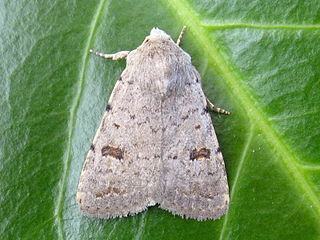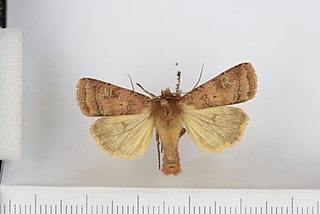
Friedrich Joseph Adalbert Seitz, was a German physician and entomologist who specialised in Lepidoptera. He was a director of the Frankfurt zoo from 1893 to 1908 and is best known for editing the multivolume reference on the butterflies and larger moths of the world Die Gross-Schmetterlinge der Erde which continued after his death.

Hadenini is a tribe of cutworm or dart moths in the family Noctuidae. There are more than 140 genera and 1,000 described species in Hadenini, found worldwide.

The large ranunculus is a moth of the family Noctuidae. It is found in Europe and North Africa.

Agrochola is a genus of moths of the family Noctuidae. The genus was erected by Jacob Hübner in 1821.

Caradrina is a genus of moths of the family Noctuidae, erected by Ferdinand Ochsenheimer in 1816 and divided into eight subgenera. These include Paradrina and Platyperigea, which some authors treat as separate genera. By 1989, it comprised 189 described species.

Cryphia is a genus of moths of the family Noctuidae. The genus was erected by Jacob Hübner in 1818.
Eremochlaena is a genus of moths of the family Noctuidae, first described by Charles Boursin in 1953. The type species is Eremochlaena oranaLucas, 1849.
Pachyagrotis is a genus of moths of the Noctuidae family, first described by Charles Boursin in 1953. The type species is Pachyagrotis ankarensis(Rebel, 1931).

Polymixis is a genus of moths in the family Noctuidae.

Cucullia argentea, the green silver-spangled shark, is a moth of the family Noctuidae. The species was first described by Johann Siegfried Hufnagel in 1766. It is found in southern and central Europe through Siberia, Mongolia and Manchuria up to Korea and Japan.

Chersotis multangula is a moth of the family Noctuidae. It is found in the mountainous areas of Central and Southern Europe, Morocco, Turkey, Armenia, Iran, Syria, Lebanon and the Caucasus.

Diarsia florida, the fen square-spot, is a moth of the family Noctuidae. The species was first described by Schmidt in 1859. It is found from western Europe, Denmark, southern Norway and southern Sweden, east to Romania and Siberia. Subspecies perturbata is found in south-eastern Turkey.

Chersotis larixia is a moth of the family Noctuidae. It is found in Spain, France, Switzerland, Italy and Sicily, Crete, Turkey, and east to Armenia, Azerbaijan, Syria, Iran, Lebanon, and Turkmenistan. In Europe, it is found in mountainous regions, like the Pyrenees, the Alps, and the Maritime Alps, up to heights of 2,000 meters.

Eugraphe sigma is a moth of the family Noctuidae. It is found from most of Europe to the Ural, Siberia, Transcaucasia, Armenia and Korea.

Luperina dumerilii, or Dumeril's rustic, is a moth of the family Noctuidae. The species was first described by Philogène Auguste Joseph Duponchel in 1826. It is found in the Mediterranean region and warmer areas of central and south-eastern Europe. Strays have been recorded from southern England. It is also present in Turkey and Jordan.

Dichagyris renigera is a moth of the family Noctuidae. It is found in South- and Southeast-Europe, Armenia, Caucasus and Turkey.

Haemerosia renalis is a moth of the family Noctuidae. It was described by Jacob Hübner in 1813. It is found in Spain, France, Italy, Sicily, Bosnia and Herzegovina, Serbia, Croatia, Slovenia, Bulgaria, North Macedonia and Greece. It has also been recorded from the Near East.

Cryphia fraudatricula is a species of moth belonging to the family Noctuidae.















